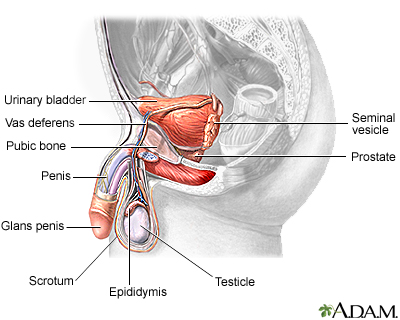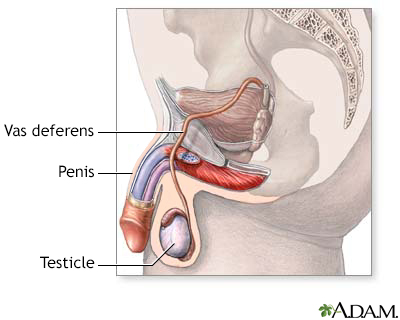Anorchia
Vanishing testes - anorchia; Empty scrotum - anorchia; Scrotum - empty (anorchia)
Anorchia is the absence of both

The male reproductive structures include the penis, the scrotum, the testes, the epididymis, the seminal vesicles, and the prostate.

The male reproductive system, viewed from a sagittal section.
Causes
An embryo develops early sex organs in the first several weeks of pregnancy. In some cases, early testes do not develop in males before 8 weeks into the pregnancy. These babies will be born with female sex organs.
In some cases, the testes disappear between 8 and 10 weeks. These babies will be born with ambiguous genitalia. This means the child will have parts of both male and female sex organs.
In some cases, the testes may disappear between 12 and 14 weeks. These babies will have a normal penis and scrotum. However, they will not have any testes. This is known as congenital anorchia. It is also called the "vanishing testes syndrome."
The cause is unknown. Genetic factors may be involved in some cases.
This condition should not be confused with bilateral undescended testes, in which the testes are located in the abdomen or groin rather than the scrotum.
Symptoms
Symptoms may include:
- Normal outside genitals before puberty
- Failure to start puberty at the correct time
Exams and Tests
Signs include:
- Empty scrotum
- Lack of male sex characteristics (penis and pubic hair growth, deepening of the voice, and increase in muscle mass)
Tests include:
- Anti-Müllerian hormone levels
- Bone density
- Follicle stimulating hormone (FSH) and luteinizing hormone (LH) levels
- Surgery to look for male reproductive tissue
- Testosterone levels (low)
- Ultrasound or magnetic resonance imaging (MRI) to look for testes in the abdomen
- XY karyotype
Treatment
Treatment includes:
- Artificial (prosthetic) testicle implants
- Male hormones (androgens)
- Psychological support
Outlook (Prognosis)
The outlook is good with treatment.
Possible Complications
Complications include:
- Face, neck, or back abnormalities in some cases
- Infertility
- Psychological issues
When to Contact a Medical Professional
Contact your health care provider if a male child:
- Appears to have extremely small or absent testicles
- Does not seem to be starting puberty during his early teens
References
Ali O, Donohoue PA. Hypofunction of the testes. In: Kliegman RM, St. Geme JW, Blum NJ, et al, eds. Nelson Textbook of Pediatrics. 22nd ed. Philadelphia, PA: Elsevier; 2025:chap 623.
Chan Y-M, Hannema SE. Differences of sex development. In: Melmed S, Auchus RJ, Goldfine AB, Rosen CJ, Kopp PA, eds. Williams Textbook of Endocrinology. 15th ed. Philadelphia, PA: Elsevier; 2025:chap 21.
Yu RN, Diamond DA. Disorders of sexual development: etiology, evaluation, and medical management. In: Partin AW, Dmochowski RR, Kavoussi LR, Peters CA, eds. Campbell-Walsh-Wein Urology. 12th ed. Philadelphia, PA: Elsevier; 2021:chap 48.
Version Info
Last reviewed on: 9/2/2024
Reviewed by: Kelly L. Stratton, MD, FACS, Associate Professor, Department of Urology, University of Oklahoma Health Sciences Center, Oklahoma City, OK. Also reviewed by David C. Dugdale, MD, Medical Director, Brenda Conaway, Editorial Director, and the A.D.A.M. Editorial team. Editorial update 02/05/2025.
